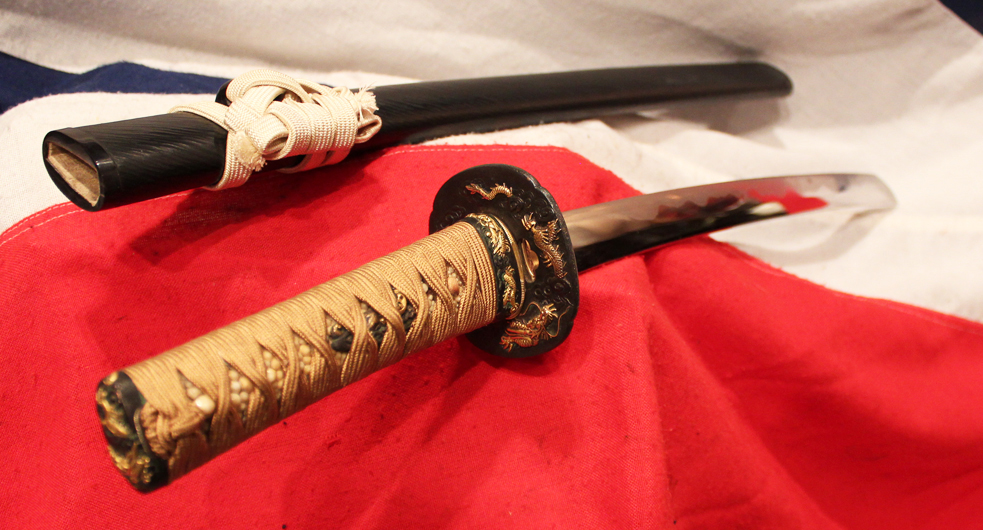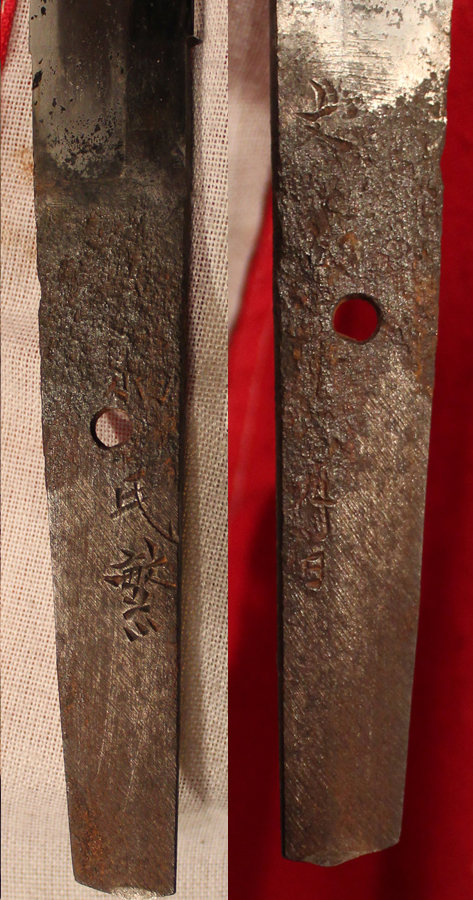A Fabulous, Museum Quality Piece Sunobi-Tanto or Ko-Wakizashi, With Stunning Quality, Soten, Shakudo and Gold Takebori Dragon Fittings,
Blade signed Takeshige, circa 1700. A very fine original samurai weapon, for a samurai of very high rank and status, it is a weapon that straddles two forms of classification a very long tanto, sunobi-tanto extra long samurai dagger or a ko-wakazashi, an extra short wakazashi the samurai’s shoto, short sword.
The complete koshirae mounts of, fushi, kashira, menuki and tsuba are Soten school, one of the most beautiful and exceptional quality forms of the schools of sword fitting makers, and all are depicting in deep takebori, the dragon in pure gold, over shakudo, patinated, hand nanako ground, copper.
The chisseling of the dragon’s features has been created in such stunning detail, and they are all true works of art in all respects.
Nanako Ji: "fish roe ground" A surface decoration produced by forming very small raised bosses by a sharply struck punch or burin called 'nanako tagane'. Shakudo is the metal most often used, but copper and gold are quite often employed. The harder metals, shibuichi, silver and iron are rarely decorated in this way. The size of the dots vary from 0.04" to 0.008" (25 to 125 and inch) and the regularity of the work is marvelous as the dots must be spaced entirely by touch. The dots are usually arranged in straight lines or in lines parallel to the edge of the piece being decorated, but sometimes in more elaborate patterns. Used on guards since the Momoyama period although the technique existed since much earlier periods. Usually done by specialist 'nanako-shi', but sometimes done by the maker of the guard himself.
The blade has A very attractive undulating hamon with distinct Shinto period yakideshi a hamon pattern change as it approaches the habaki and all the blade is in nice bright polish. The blade has a few natural old age pitting marks as can be expected and one around the length of a small grain of rice, around 5 inches from the tip. The saya is decorated in beautiful black sprial ishime stone finish lacquer.
O-Tanto or Sunobi Tanto
The Tanto that varied from the traditional size were called Sunobi-Tanto or O-Tanto. These were larger versions of the Tanto which featured blades usually measuring between 13 to 14 inches long. It was close to the size of the Ko-Wakizashi, which is a shorter version of the Wakizashi. However as this blade is even longer that the usual 14 inches, that is why it can be considered as a transitional weapon that has a foot in both camps so to speak. Because of its often small size, the Samurai warriors were able to conceal the Tanto in their clothing. It was also the Shoto or small sword in the Daisho and was paired with the Tachi. This was before the Samurai chose to use the Wakizashi over the Tanto as an auxiliary sword.
The Wakizashi was a Samurai warrior’s backup weapon that was used for close-quarter battles. Aside from this, the sword was a Samurai warrior’s tool for beheading a defeated opponent. It was sometimes used for committing Seppuku, a ritualistic suicide.
In addition, the Wakizashi was one of the few short swords available to the Samurai warrior. Another sword they might use was called a Chisa Katana, effectively a short Katana perfect for use within buildings castles etc. and the prerogative of the personal full time bodyguard of a Daimyo lord, who were the usually the only samurai permitted to be armed in his presence day and night.
Because the sword was the main battle weapon of Japan's knightly man-at-arms (although spears and bows were also carried), an entire martial art grew up around learning how to use it. This was kenjutsu, the art of sword fighting, or kendo in its modern, non-warlike incarnation. The importance of studying kenjutsu and the other martial arts such as kyujutsu, the art of the bow, was so critical to the samurai a very real matter of life or death that Miyamoto Musashi, most renowned of all swordsmen, warned in his classic The Book of Five Rings: The science of martial arts for warriors requires construction of various weapons and understanding the properties of the weapons. A member of a warrior family who does not learn to use weapons and understand the specific advantages of each weapon would seem to be somewhat uncultivated. European knights and Japanese samurai have some interesting similarities. Both groups rode horses and wore armour. Both came from a wealthy upper class. And both were trained to follow strict codes of moral behaviour. In Europe, these ideals were called chivalry; the samurai code was called Bushido, "the way of the warrior." The rules of chivalry and Bushido both emphasize honour, self-control, loyalty, bravery, and military training
The blade tsuba to tip 15.25 inches, full length 22 inches.
Code: 22884










